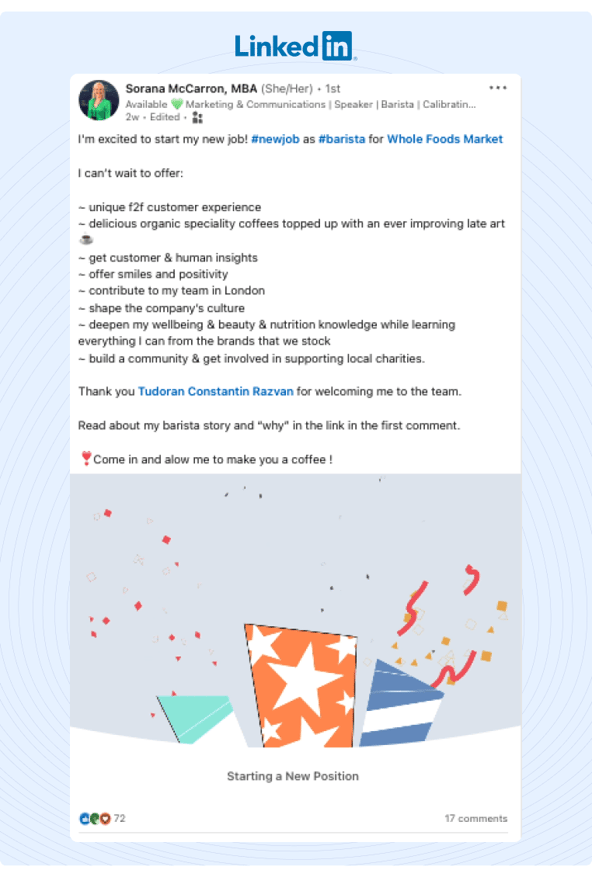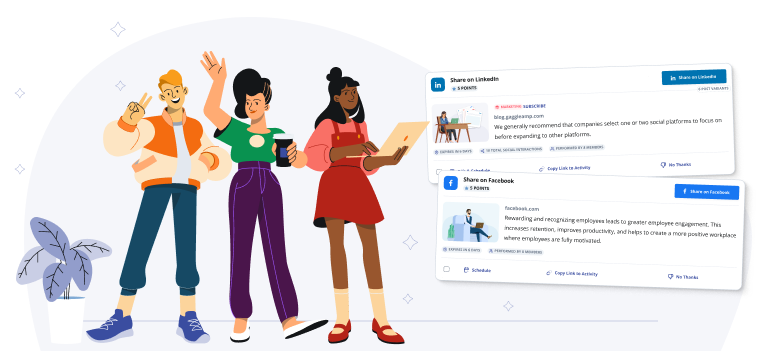Use Employee Engagement to Promote Genuine Employee Advocacy
Have you ever wondered why some employees feel so deeply for their workplace while for others it’s just another day of shifting gears in traffic? Why do you think that happens?
The answer is quite obvious, and it’s because some organizations go the extra mile to make their employees feel appreciated and engage them regularly. Studies reveal that organizations that engaged their employees saw a massive 21% jump in their profits.
What triggered that jump?
- Firstly, employees identified with the company better because of good communication and were more satisfied with the environment, which motivated them to perform better.
- Secondly, happier employees promote their workplace over social media and other channels, sponsoring employee advocacy.
Let’s understand this further by starting with a few basics.
Understanding Employee Engagement
Great organizations thrive on devoted, passionate employees who work with a sense of purpose. Employee engagement binds an individual to these goals.
It makes employees want to see their jobs as something more than a paycheck at the end of each month and connects their work to their well-being. Employees feel more driven to perform when they know their contributions are valued and that they make a difference.
Well, that sounds great in theory, but it takes effort and external stimuli to drive employee engagement. Let’s check out a few ways in which you can do that.
- Communicate with your employees regularly through emails, group discussions, and webinars. Update them and ask for their feedback.
- Offer them the opportunity to advance in their roles through training sessions, skill-building, tuition reimbursement, and more. Thus, you’ll increase employee retention.
- Recognize their achievements and reward them. Let them know you value their contributions and motivate them to continue working with a similar passion.
- Provide them with a flexible work schedule. Try to be accommodating toward their workload to foster a growth-led environment.
- Be transparent, and involve them in decision-making processes so they feel important.
We all know you can’t drive a vehicle without gas, but you need to make an effort to go to a gas station and pump it in. That’s precisely what you need to do with employee engagement; take deliberate steps to ensure everyone is equally engaged.
It takes effort to keep an employee engaged, but once you crack the code, the benefits overpower everything. Let’s see how.
Understanding Employee Advocacy

It’s a no-brainer that employees are considered more trustworthy than brands, and their endorsements can carry a lot of weight.
An employee advocacy program is a powerful marketing tool that allows companies to tap into their employees’ social networks. It is when employees promote the employer or message around their employer or industry on their digital channels.
This differs from being a brand ambassador because you don't get paid for these promotions. You do it because you genuinely feel drawn to do so.
Before drafting an advocacy plan, here are a few points to understand:
- Define your outcome. Ask yourself if you need a plan to increase sales or brand awareness. Setting your goals right will help you measure the success rate better.
- Pick your advocates. Not all your employees will be interested in using personal accounts for business, so target people who are willing.
- Training is essential. You don't want your employees to over-share, so draw your boundaries and educate your advocates to stay within them.
- Metrics are the real deal. Draw a workable conclusion using performance metrics, and tweak your plan if necessary.
Once you have these steps sorted, you can move on to implementing them and reaping the benefits.
How Do Employee Engagement and Employee Advocacy Co-Exist?
Our sales and marketing teams are morally inclined to talk about the organization because it's their job. The rest of the employees won’t do it unless they get something out of it.
Imagine this group of people posting about their experiences in the workplace over social media. Say a new employee is greeted by warm welcome messages from the team, and they share the same on their social media channels.

Don’t you think that post becomes ten times more valuable because it’s voluntary? Let’s look at an example.
- Think of it as promoting a company because you like its products.
- A company would follow up with thank-you emails, feedback surveys, discounts, and offers, making you feel more valued as a customer.
- What do you do in exchange? You talk about it in your friend circle and on social media platforms and promote their products, even when they didn’t ask you to.
- All they did was engage you, and you instantly felt more connected to the company.
Employee engagement and employee advocacy are deeply rooted in the basic idea of trust. Your people need to feel personally connected to your company and its goals if you want them to promote your workplace positively.
How to Leverage Employee Engagement to Drive Advocacy

So far, we know three things:
- Engagement and advocacy are two sides of the same coin.
- Give opportunities for employees to connect personally by bringing in more engagement.
- Trust, transparency, and togetherness are three operative words of both engagement and advocacy in the workplace.
Now let’s understand how you can promote engagement in a way that benefits your advocacy program.
1. Sync Employee Key Result Areas (KRA) with Overall Organizational Goals
Every employee should have professional goals, but they should all align with the organization’s goals. All the efforts should be directed towards achieving a common goal. For that to happen, you need to identify that common goal and then educate your employees accordingly.
You don’t want them to make plans out of thin air, which is why orientation and training are necessary. Here are a few points to note:
- Make the information detailed but not tedious. Using infographics to present heavy data or even something as simple as a good presentation could do the trick.
- Reiterate the goal repeatedly through interactive emails, quizzes, and gamification. Use good email account management software to track results and send information without wasting time.
- Give them direction. They need to know if their efforts are reaping results and how they can improve them further.
If you deal with a remote workforce, hire a virtual assistant to draw out the details like KRA, consolidate feedback, or discuss them with your employees as often as possible. Offer them career goal examples to motivate them to work in a similar direction.
The better they understand the goals, the more engaged they are in achieving them and the more motivated they feel. This forms a strong foundation, making the ask to participate in your company’s employee advocacy efforts that much easier.
2. Bring in More Involvement
Your employees can’t enjoy a game from a bench. Instead, make them play, and let them feel like they are a part of the team.
Make them feel empowered and confident to share their ideas; more than that, they need to be recognized for this continuation. Additionally, the executive team should be approachable and help guide employees.
If their ideas see the light of day and are implemented, give them credit because that promotes trust and credibility. Some other advantages include:
- Receiving more ideas than you traditionally had.
- Gaining the opportunity to know your employees better through their ideas.
- Accessing to instant feedback that can be used to strengthen the workflow.
Increased comradery builds collaboration, trust, and value. And, let’s be honest, being recognized and acknowledged does a world of wonder for all of us. By being more involved in decisions at your company, you’re also more likely to bring awareness to those efforts in your employee advocacy activities.
3. Promote Thought Leadership
To cultivate thought leadership amongst employees, you need to go a step further and applaud their efforts in a much more significant way. Here are a few things you could do:
- Open deeper communication channels, and present a more approachable stance in front of your employees.
- Make your office more open, remove the walls, and bring in more collaboration.
- Promote their ideas on social media (this makes for an excellent opportunity to leverage employee advocacy platforms like GaggleAMP).
- Ask your employees to share their unique plans and foresight for the company, and encourage them to go limitless with their ideas.
- Make them feel proud for coming forward and sharing an idea by helping them reach more people.
Here’s a small example of what you can do. Ask your employees to make a 30-second internal video on a trending industry topic, and then share the brightest ideas on your public profile. You can stitch these videos together and make a whole carousel.
Acknowledging their efforts publicly will encourage employees to share, understand the industry better, and bring more value to work.
4. Reflect the Company Values in Your Conduct
Practice what you preach—your company values should reflect in your culture.
Employees are much more likely to talk positively about the company when they trust and respect it more.
Your company culture should look authentic, and people should understand it. Having values that are complicated to understand can lead the employee astray, which will decrease their work productivity.
However, it is advisable to make this interaction two-way and ask the employees what they feel should be the values of a good organization. Engage them in a conversation to fully understand their expectations, and they will be much happier at work.
Advocacy can take many forms, from social media posts and online reviews to word-of-mouth recommendations. But it all starts with engagement. If you can engage your employees in their work, they will be more likely to advocate for your company.
Conclusion
Engaged employees will stick to your company for extended periods, reducing labor turnover and training costs. Additionally, existing employees are more attentive and willing to add more value since they are emotionally committed to the company.
Provide opportunities for career growth, offer competitive compensation and benefits, and create a positive work environment. By investing in your employees, you reap the rewards of a more engaged workforce—and a more successful company.








